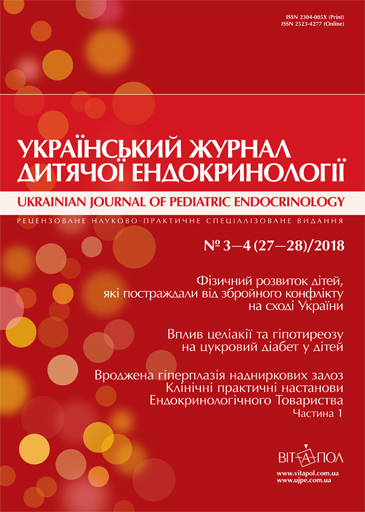Гелеофізична дисплазія: різні клінічні прояви одного гена
DOI:
https://doi.org/10.30978/UJPE2018-3-4-56Ключові слова:
гелеофізична дисплазія, низькорослість, генетичне тестування, FBN1 мутації, лікуванняАнотація
Гелеофізична дисплазія (ГД) — це рідкісний мультисистемний розлад, що характеризується ураженням кісток, суглобів, серця та шкіри. Тип спадкування ГД є різним і може бути автосомно-рецесивним у випадку мутацій в гені ADAMTSL2 та автосомно-домінантним у випадку мутацій у генах FBN1 та LTBP3. У статті наведено приклад власного спостереження двох пацієнтів з різних сімей, які мали різну клінічну картину ГД, але загальною рисою яких була виражена низькорослість з резистентністю до лікування гормоном росту.
Звичайні ендокринні тести не виявили первинної ендокринної патології. У кожній сім’ї проведено генетичне дослідження методом екзомного секвенування. В обох пацієнтів виявлено de novo гетерозиготні FBN1 мутації p.Tyr1696Asp і p.Cys1748Ser. Обидві дитини мали такі спільні клінічні симптоми, як виражена низькорослість, характерні риси обличчя, короткі кінцівки, а також суглобові контрактури. Водночас в одного пацієнта було виявлено серцеву патологію, тоді як інший мав стеноз трахеї, що вимагав трахеостомії.
Пацієнти з вираженою низькорослістю, скелетними аномаліями та іншими специфічними синдромами (наприклад, стенозом трахеї та серцевими аномаліями) повинні пройти генетичне тестування, щоб виключити синдроми акромелічної дисплазії.
Посилання
Le Goff C, Cormier-Daire V. Genetic and molecular aspects of acromelic dysplasia. Pediatr Endocrinol Rev. 2009;6:418-423.
Pontz BF, Stoss H, Henschke F et al. Clinical and ultrastructural findings in three patients with geleophysic dysplasia. Am J Med Genet. 1996;63:50-54.
Le Goff C, Cormier-Daire V. From tall to short: the role of TGFβ signaling in growth and its disorders. Am J Med Genet C. Semin Med Genet. 2012:145-153.
De Bruin C, Finlayson C, Funari MF A et al. Two Patients with Severe Short Stature due to a FBN1 Mutation (p.Ala1728Val) with a Mild Form of Acromicric Dysplasia. Horm. Res. Paediatr, DOI: 10.1159/000446476.
Le Goff C, Morice-Picard F, Dagoneau N et al. ADAMTSL2 mutations in geleophysic dysplasia demonstrate a role for ADAMTS-like proteins in TGF-beta bioavailability regulation. Nat Genet. 2008;40(9):1119-1123.
Le Goff C, Mahaut C, Wang L et al. Mutations in the TGFb Binding-Protein-Like Domain 5 of FBN1 Are Responsible for Acromicric and Geleophysic Dysplasias. The American Journal of Human Genetics. 2011;89,7-14,July15:7-14.
McInerney-Leo AM, Le Goff C, Leo PJ et al. Mutations in LTBP3 cause acromicric dysplasia and geleophysic dysplasia. J Med Genet. 2016;Jul.53(7):457-64.
Aubart M, Benarroch L, Arnaud P, Collod-Bеroud G, Jondeau G and Boileau C. Molecular Genetics of the Fibrillinopathies. Wiley Online Library, https://doi.org/10.1002/9780470015902.a0025314, 2016.
Sakai L, Keene D, Renard M, De Backer J. FBN1: The disease-causing gene for Marfan syndrome and other genetic disorders.Gene. 2016;10,591(1):279-291.
Dietz H, Cutting G, Pyeritz R et al. Marfan syndrome caused by a recurrent de novo missense mutation in the fibrillin gene. Nature. 1991;352:337-339.
De Bruin C, Mericq V, Andrew SF et al. An XRCC4 splice mutation associated with severe short stature, gonadal failure, and early-onset metabolic syndrome. J Clin Endocrinol Metab. 2015 May;100(5):789-798.
Salgado D, Desvignes J, Rai G et al. UMD-Predictor: A High-Throughput Sequencing Compliant System for Pathogenicity Prediction of any Human cDNA Substitution. Hum Mutat. - 2016-2015 May;37(5):439-46. doi: 10.1002/humu.22965.
Kircher M, Witten D, Jain P et al. A general framework for estimating the relative pathogenicity of human genetic variants. Nat Genet. 2014, Mar;46(3):310-52014. doi: 10.1038/ng.2892.
Schwarz J, Cooper D, Schuelke M, Seelow D. MutationTaster2: mutation prediction for the deep-sequencing age. Nat Methods. 2014, Apr;11(4):361-2. doi: 10.1038/nmeth.2890.
Rama G, Chung WK, Cunniff CM, Krishnan U. Rapidly progressive mitral valve stenosis in patients with acromelic dysplasia. Cardiol Young. 2017, May;27(4):797-800.
Scott A, Yeung S, Dickinson DF et al. Natural history of cardiac involvement in geleophysic dysplasia. American J Med Genet. 2005;A:132A:320-323.
Hasegawa K, Numakura C, Tanaka H et al. Three cases of Japanese acromicric/geleophysic dysplasia with FBN1 mutations: a comparison of clinical and radiological features. J Pediatr Endocrinol Metab. 2017, Jan;1,30(1):117-121, doi: 10.1515/jpem-2016-0258.
Wang Y, Zhang H, J Ye, Han L, Gu X. Three novel mutations of the FBN1 gene in Chinese children with acromelic dysplasia. J Hum Genet. 2014, Oct;59(10):563-567.
Cecchi A, Ogawa N, Martinez HR et al. Missense mutations in FBN1 exons 41 and 42 cause Weill-Marchesani syndrome with thoracic aortic disease and Marfan syndrome. Am J Med Genet A. 2013, Sep;161A(9):2305-2310.
Hagenаs L, Hertel T. Skeletal dysplasia, growth hormone treatment and body proportion: comparison with other syndromic and non-syndromic short children. Horm Res. 2003;60(S3):65-70.
Jin H, Song H, Cho S et al. Acromicric Dysplasia Caused by a Novel Heterozygous Mutation of FBN1 and Effects of Growth Hormone Treatment. Ann Lab Med. 2017, Jan;37(1):92-94.
Faivre L, Le Merrer M, Baumann CM et al. Acromicric dysplasia: long term outcome and evidence of autosomal dominant inheritance. J Med Genet. 2001;38:745-749.





